By Lucy Komisar
Feb 4, 2016
Art as politics reaches new intensities in the Whitney Museum‘s disturbing and powerful new exhibit of film maker Laura Poitras‘ selection of videos and documents to define the U.S. government‘s threats to liberty after 9/11. The exhibit opens in New York Feb 5 and continues till May 1, 2016.
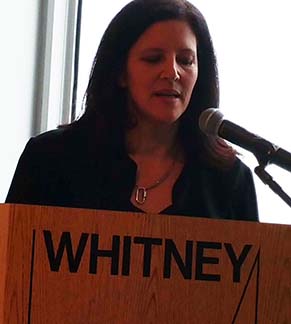
Astro Noise, the name of the show, comes from the faint background disturbances of thermal radiation left over from the Big Bang, the start of our universe.
It is the name Edward Snowden gave the encrypted file with evidence of mass surveillance by the National Security Agency that he provided to Poitras in 2013. She would make the documentary, “Citizenfour,” about Snowden.
The most upsetting part of the exhibit is a 12-minute film produced by the U.S. military of two prisoners they were interrogating in Afghanistan, imprisoned there in 2001.
Salim Hamdan and Said Boujaadia are held in dungeon-like conditions, often hooded.
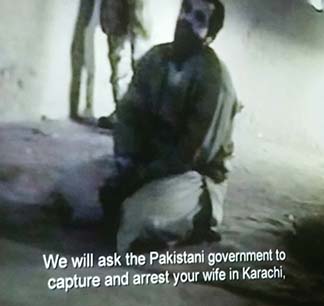
The longer interrogation is of Salim Hamdan, a Yemeni captured during the invasion of Afghanistan, and declared by the U.S. an illegal enemy combatant. He said he had worked as Osama bin Laden’s driver for the money.
The interrogator says, We will ask the Pakistani government to capture and arrest your wife in Karachi.
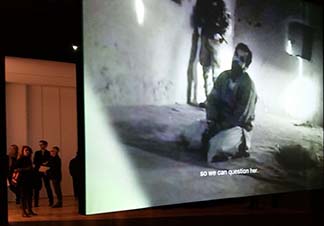
In the end, after more than five years of prison in Guantanamo and Yemen, his conviction was overturned by the U.S. Court of Appeals in Washington and he was acquitted of all charges.
The video was obtained as evidence in the U.S. court case. Hamdan and his brother-in-law were the subjects of Potras‘ documentary, “The Oath,” in 2010.
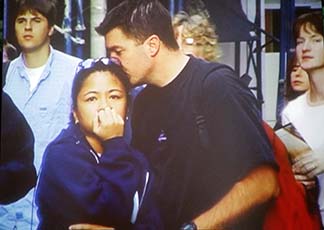
The reverse of the screen shows stunned “viewers” and their reactions. In fact, ironically, they are viewing ground zero after the 9/11 attack. Still significantly opposite sides of the same screen as vision.
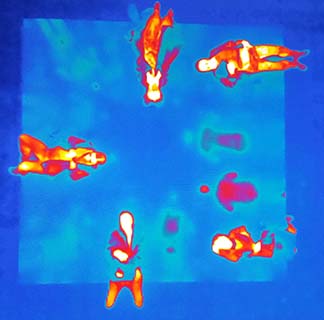
There is involvement by museum-goers, witting and not. People are invited to lie on a platform in a dark room and look up to gaze at what they might see from the courtyards of homes in Yemen, Somalia, and Pakistan.
And in the other room, we see those – our – bodies as multi-color drone targets.
In a dark twisting room, providing a vision of the secretive Deep State, exhibits of documents, drawings and videos are seen through voyeuristic peepholes that offer only partial views.
There‘s a 2002 memo from CIA Director George Tenet on increasing the agency‘s cooperation with the NSA.
Also cell phone footage of casualties from a Sept 2012 U.S. airstrike in Yemen.
And a prisoner‘s line drawings of implements of torture at a secret CIA detention sites in Afghanistan.
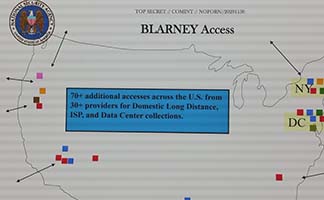
A home video presents two days in a town in Yemen. The first shows a wedding, the second the results of a U.S. drone strike, taken by a man whose brother-in-law and nephew were killed in the strike.
And then, for the visitors who have cell phones, in case they think this exhibit is about others, a monitor showing the wi-fi signals coming from those phones via Wi-Fi Snifter software by Surya Mattu.
Poitras, who had been living in Berlin as a result of U.S. government harassment when she entered or left the country, returned to New York to prepare the show. After “Citizen Four,” her profile is so strong that she can cross the American border with the same freedom as most citizens.
Museum director Adam Weinberg sets the show in “in the tradition of socially and politically engaged artists…progressive artists such as Ben Shahn and Alice Neal.” He said, “The aim of the projections is to provoke moral and ethical responses.” Indeed, they do. Or they should.
“Astro Noise,” by Laura Poitras. Whitney Museum of Art, 99 Gansevoort Street, New York City, bet Washington St. & 11th Ave. Daily except Tues. Opens 10:30 am. Under 18 free. Students/seniors $18. Adults $22. On Fridays, 7–10 pm, admission is pay-what-you-wish. 2/4/16. Also on Portside.


Pingback: BibSonomy :: url :: Poitras exhibit at Whitney turns U.S. govt threat to liberty into political art | The Komisar Scoop